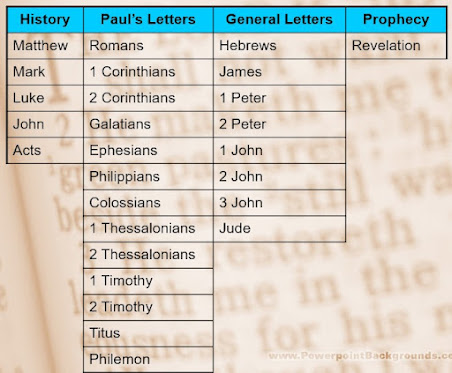This blog contains a summary of the message of the Bible, description of how the Bible is organized, and suggestions for Bible reading.
If someone who had never seen or read a Bible asked you, “What’s that book about?,” what would you say?
The Bible is about redemption (deliverance)
through Jesus Christ. One early Christian leader described four states of Redemptive
history (Augustine, 354-430 AD).
· Creation:
able to sin, able not to sin (posse peccare, posse non peccare)
· Fall:
not able not to sin (non posse non peccare)
· Redemption:
able not to sin (posse non peccare) – again
· Consummation: not able to sin (non posse peccare)
Another way to identify the purpose of the Bible is to see what the Bible says about itself. Note the following verses.
· “I
have hidden your word in my heart that I might not sin against you” (Psalm
119:11).
· “When
you received the word of God… you accepted it not as the word of men, but as it
actually is, the word of God, which is at work in you who believe” (1 Thess.
2:13).
· “All
Scripture is God-breathed and is useful for teaching, rebuking, correcting and
training in righteousness so that the man (person) of God may be thoroughly
equipped for every good work” (2 Timothy 3:16, 17).
· “For the word of God is living and active. Sharper than any double-edged sword, it penetrates even to dividing the soul and spirit, joints and marrow; it judges the thoughts and attitudes of the heart” (Hebrews 4:12).
The Bible is a library of different types of
literature, rather than a single book (Greek biblia—books [plural]).
•
66 Books total
•
Old Testament: 39 books
• New Testament: 27 books
Old Testament Structure
New Testament Structure
The Bible is meant to be read and if you are interested, you may want to begin by reading selected passages or having a daily reading or listening plan or even starting with any place that looks interesting.
1. Selected passages to consider could be the
following five Bible books.
•
Genesis: early history
•
Psalms: poetry
•
Mark: life and ministry of Jesus
•
Acts: early church
• 1 Peter: letter to churches
2. A daily reading or listening plan is helpful for many. The following link is an example of one plan. You can read the Bible in a year with a printed plan like this.
My wife and I listen to the Bible each morning with the Daily Audio Bible.
3. You could also begin with any topic that is of personal interest. Think of a topic and Google it with the word “Bible” in the search line (e.g., faith, hope, joy, temptation, encouragement).
This blog has contained beginning thoughts about introducing the Bible. The purpose of the Bible is to tell the story of redemption through Jesus Christ. This is called “redemptive history.” The Bible is a book containing 66 books that are divided into the Old and New Testaments. You are encouraged to read the Bible for yourself and decide how its message applies to you.
To learn more, you will find free e-books,
videos, and articles as well as recommendations for purchasing books and other
products in the Virtual Resource Center at the top of this site.
If looking for a Study Bible, click here.
Church and School Education (CASE) Resources is a participant in the Amazon Services LLC Associates Program, an affiliate advertising program designed to provide a means for sites to earn advertising fees by advertising and linking to Amazon.com.
To view this presentation on my Youtube channel, click here.
For a free e-book, The Beginner's Guide to the Bible, click here.




No comments:
Post a Comment